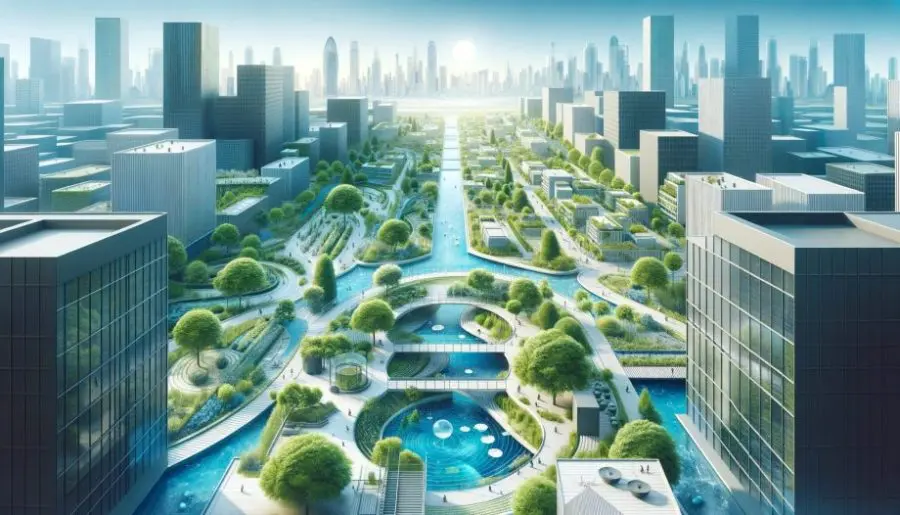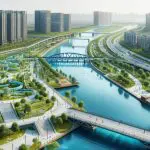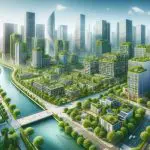
What is blue-green infrastructure? Discover an innovative approach blending nature with urban design for a sustainable, resilient future.
Blue-Green Infrastructure Key Takeaways:
- Blue green infrastructure is a strategic blend of natural and man-made elements in urban areas.
- It combines green spaces like parks and gardens with blue elements such as rivers and ponds.
- This integration helps manage water sustainably while providing environmental, social, and economic benefits to urban communities.
What Is Blue-Green Infrastructure?
Curious about blue-green infrastructure? It’s a groundbreaking concept in urban planning, seamlessly integrating natural elements like trees and waterways into cityscapes.
A blue infrastructure approach doesn’t just beautify our cities; it plays a critical role in making them more sustainable and resilient against the challenges of modern living.
Revolutionizing Urban Planning Blue-Green Infrastructure (BGI) is transforming the approach to urban planning. It addresses critical issues like climate change, the urban heat island effect, and environmental degradation.
Integrating Nature in Cities This strategy incorporates nature-based solutions, and natural and semi-natural elements into urban areas, enhancing sustainability and resilience. BGI’s unique combination of green spaces and water management systems offers an eco-friendly solution to the challenges posed by urbanization and extreme weather.
Essential for Sustainable Development BGI is not just an environmental initiative; it’s a vital component for the sustainable evolution of modern cities. By blending ecological systems with urban development, BGI ensures that our cities are prepared for the future, balancing growth with environmental stewardship.
Understanding Blue-Green Infrastructure
Definition of Blue-Green Infrastructure
Blue-Green Infrastructure (BGI) is an integrated approach to urban development, blending natural and semi-natural elements within cityscapes.
This innovative strategy focuses on utilizing these elements for effective and sustainable water management while simultaneously offering substantial societal benefits.
Green infrastructure or blue-green infrastructure refers to a network that provides the “ingredients” for solving urban and climatic challenges by building with nature.[1] The main components of this approach include stormwater management, climate adaptation, the reduction of heat stress, increasing biodiversity, food production, better air quality, sustainable energy production, clean water, and healthy soils, as well as more anthropocentric functions, such as increased quality of life through recreation and the provision of shade and shelter in and around towns and cities. Wikipedia
Components of Blue-Green Infrastructure
BGI includes a variety of components that work synergistically:
- Blue Elements: These are water-based features such as rivers, ponds, and wetlands. They play a critical role in managing the urban water cycle, including stormwater management and water purification.
- Green Elements: This category encompasses terrestrial elements like trees, parks, and gardens. They contribute to improving air quality, enhancing biodiversity, and providing recreational spaces.
The harmonious combination of these blue and green elements forms the backbone of Blue-Green Infrastructure, offering a multifaceted approach to addressing urban greening and environmental and social challenges.
Through BGI, cities can become more resilient and adaptable to the impacts of climate change and urban growth.
Table: Understanding Blue-Green Infrastructure
| Element | Description |
|---|---|
| Blue Elements | Rivers, ponds, wetlands |
| Green Elements | Trees, parks, gardens |
The Need for Blue-Green Infrastructure
Urban Challenges Addressed by BGI
Blue-Green Infrastructure (BGI) emerges as a crucial solution in the face of growing urban challenges.
It addresses key issues such as urban flood resilience, the impacts of climate change, and widespread environmental degradation.
By managing stormwater runoff naturally and enhancing urban ecosystems, BGI plays a significant role in making cities more sustainable and livable.
Shift from Grey to Blue-Green Infrastructure
Traditionally, cities have relied on grey infrastructure composed of concrete and steel to manage water and urban development.
However, this approach often fails to address the complex environmental challenges of modern urban areas.
BGI represents a paradigm shift, moving towards more sustainable and eco-friendly solutions that blend seamlessly with the natural environment.
This shift not only enhances urban resilience but also contributes to the overall health of urban ecosystems.
Table: The Need for Blue-Green Infrastructure
| Challenge | BGI Solution |
|---|---|
| Environmental Degradation | Improves urban flood resilience, addresses climate change impact |
| Shift from Grey to BGI | Enhances sustainability, promotes ecosystem health |
Benefits of Blue-Green Infrastructure
Blue-Green Infrastructure (BGI) offers a range of benefits that span across environmental, economic, and social domains.
Environmental Benefits
- Improved Water Regulation: BGI enhances water management, effectively handling stormwater and reducing flood risks.
- Air Quality and Cooling Effects: The green elements in BGI contribute to cleaner air and mitigate urban heat islands, making cities cooler and more comfortable.
Economic Advantages
- Cost-Effectiveness: Over time, BGI proves to be more economical compared to traditional infrastructure, due to its sustainable nature and reduced maintenance costs.
- Value Addition: BGI enhances property values and can lead to economic uplift in urban areas.
Social Benefits
- Enhanced Quality of Life: BGI provides green open space for recreation, improving the overall well-being of residents.
- Community Engagement: These spaces foster a sense of community and encourage social interactions among urban dwellers.
By encompassing these diverse benefits, BGI presents a comprehensive solution to urban environmental challenges, delivering value on multiple fronts.
Table: Benefits of Blue-Green Infrastructure
| Advantage Type | Benefits |
|---|---|
| Environmental | Improved water and air quality, cooling effects |
| Economic | Cost-effectiveness, property value enhancement |
| Social | Improved quality of life, recreational spaces, community engagement |
Global Examples of Blue-Green Infrastructure
Exploring global examples of Blue-Green Infrastructure (BGI) provides valuable insights into its diverse applications and benefits.
Cities like Rotterdam, Ningbo, Newcastle, and Portland have implemented BGI with varying approaches, achieving remarkable outcomes in urban water management and community engagement.
These case studies illustrate the adaptability and effectiveness of BGI in different urban contexts.
Rotterdam, Netherlands
- Innovative Water Management: In Rotterdam, BGI is essential for climate resilience. As a low-lying city, it uses BGI to manage rising sea levels and flooding.
- Community Involvement: Projects like water plazas and green roofs engage the community and provide recreational spaces.
Ningbo, China
- Sponge City Initiative: Ningbo is a part of China’s Sponge City Program, incorporating BGI to mitigate flood risk and store water for future use.
- Urban Transformation: The city has integrated features like rain gardens and wetlands, transforming urban landscapes and improving water quality.
Newcastle, UK
- Urban Water Management: Newcastle’s BGI focuses on creating blue-green corridors to manage rainfall and reduce flood risks.
- Collaborative Approach: The city’s strategy involves collaboration between government, communities, and experts, showcasing a comprehensive approach to BGI.
Portland, Oregon, USA
- Investment in Green Spaces: Portland’s substantial investment in BGI includes green streets and private landowner incentives for rain garden installations.
- Enhancing Urban Ecology: These initiatives have not only improved stormwater management but also enriched local biodiversity and recreational opportunities.
Each of these cities demonstrates the transformative impact of BGI, offering unique solutions tailored to their specific environmental and urban challenges.
Table: Global Examples of Blue-Green Infrastructure
| City | Key Features |
|---|---|
| Rotterdam | Climate resilience, water management |
| Ningbo | Sponge City Program, flood mitigation |
| Newcastle | Urban water management, collaborative approach |
| Portland | Green streets, private landowner rain garden incentives |
5. Challenges and Innovations in Implementing BGI
Introduction Integrating Blue-Green Infrastructure (BGI) into urban planning is a complex task involving various challenges and innovations. The process requires coordination among different stakeholders and innovative governance approaches. This section explores how cities worldwide are navigating these complexities and successfully integrating BGI into their urban landscapes.
Governance and Policy Integration
- Multifaceted Coordination: Implementing BGI involves coordinating with a range of stakeholders, including government bodies, private sector, and local communities. This requires innovative governance models that can integrate diverse interests and expertise.
- Policy Challenges: Adapting existing policies or creating new ones that support BGI initiatives is crucial. This often involves navigating bureaucratic hurdles and ensuring policy alignment with sustainable urban planning goals.
Innovative Solutions in Cities
- Case Study Examples: Cities like Rotterdam and Ningbo demonstrate unique approaches to overcoming these challenges. Rotterdam’s focus on climate resilience has driven its BGI initiatives, while Ningbo’s Sponge City Program showcases how policy can drive BGI implementation.
- Overcoming Barriers: These cities exemplify how overcoming governance and policy barriers can lead to successful BGI projects, emphasizing the need for flexible and adaptive governance structures.
The journey of integrating BGI into urban planning is marked by challenges but also by innovative solutions that pave the way for more resilient and sustainable cities.
Table: Challenges and Innovations in Implementing BGI
| Challenge/Innovation | Description |
|---|---|
| Governance & Policy | Multifaceted coordination, policy challenges |
| Case Study Examples | Rotterdam’s climate resilience, Ningbo’s policy-driven approach |
6. The Future of Blue-Green Infrastructure
Introduction The future of Blue-Green Infrastructure (BGI) is poised at an exciting juncture, with evolving trends and prospects shaping its role in urban development. As we look ahead, technological advancements and policy shifts are expected to significantly influence the implementation and effectiveness of BGI. This section delves into what the future may hold for this sustainable approach to urban planning.
Trends in Urban Development and BGI
- Expanding Scope: The scope of BGI is expanding beyond water management to address broader urban challenges like biodiversity conservation and community wellbeing.
- Integration with Urban Design: BGI is increasingly being integrated into the fabric of urban design, becoming a standard part of new developments and regeneration projects.
Technological Advancements
- Innovative Materials and Designs: The use of advanced materials and innovative design solutions is enhancing the efficiency and effectiveness of BGI systems.
- Digital Technologies: Technologies like IoT and AI are being leveraged for better monitoring and management of BGI systems, making them more adaptable and responsive to environmental changes.
Policy Shifts and Implementation
- Policy Support and Funding: A shift towards stronger policy support and increased funding is crucial for the widespread adoption of BGI.
- Collaborative Approaches: Emphasizing collaborative and multi-disciplinary approaches in policy-making and implementation can accelerate BGI adoption.
Sustainable and Resilient Urban Futures
- Climate Change Adaptation: As cities grapple with the effects of climate change, BGI is becoming a key element in adaptation strategies, offering a nature-based solution to urban environmental challenges.
- Enhanced Quality of Life: The integration of BGI contributes to a higher quality of urban life, making cities more livable and sustainable.
The trajectory of BGI points towards a more resilient and environmentally harmonious future for urban areas, driven by innovation, policy evolution, and a growing recognition of its multifaceted benefits.
What Is Blue-Green Infrastructure? FAQs
Introduction In this section, we answer some of the most commonly asked questions about Blue-Green Infrastructure (BGI). From cost considerations to its effectiveness in various climates, and maintenance requirements, these FAQs aim to clarify doubts and provide a deeper understanding of BGI and its implementation in urban environments.






